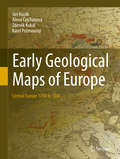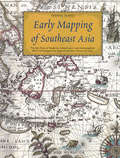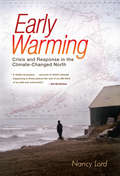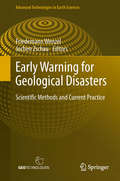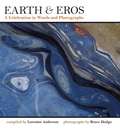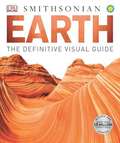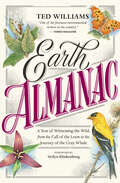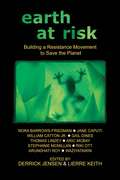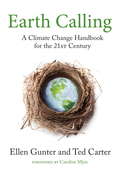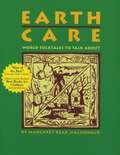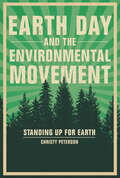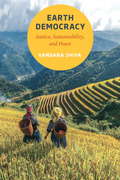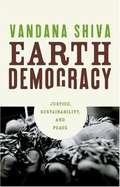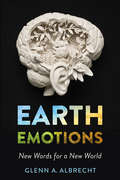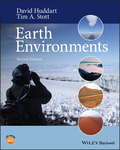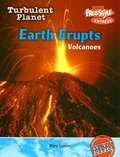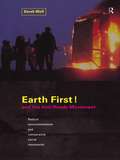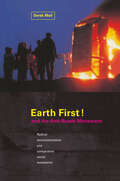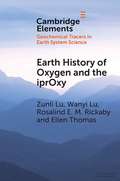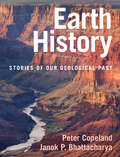- Table View
- List View
Early Geological Maps of Europe
by Jan Kozák Alena Čejchanová Zdeněk Kukal Karel PošmournýThis book focuses on the presentation and evaluation of geological maps of the Central Europe from 1750 up to 1840. Milestones in presentation of stratigraphy and tectonics and new geological models on such maps will be underlined. Map descriptions contain fundamentals editorial data as well as the map author's affiliation and biographies. It represents for the region of the Central Europe the first work of this type. Geological maps represent geological synthesis and indicate the level of geological knowledge throughout history. They serve as guidelines for an economic utilization of mineral deposits and further geological investigation.
Early Mapping of Southeast Asia
by Thomas SuarezEarly Mapping of Southeast Asia follows the story of mapmaking, exploration and colonization in Asia from the 16th to the 19th centuries. It surveys Southeast Asia's geography and civilizations, its maps and their influence on Western worldviews, as well as the image of Southeast Asia in the eyes of its neighbors.
Early Warming: Crisis and Response in the Climate-Changed North
by Nancy LordIn Shishmaref, Alaska, new seawalls are constructed while residents navigate the many practical and bureaucratic obstacles to moving their entire island village to higher ground. Farther south, inland hunters and fishermen set out to grow more of their own food-and to support the reintroduction of wood bison, an ancient species well suited to expected habitat changes. First Nations people in Canada team with conservationists to protect land for both local use and environmental resilience.In Early Warming, Nancy Lord takes a cutting-edge look at how communities in the North-where global warming is amplified and climate-change effects are most immediate-are responding with desperation and creativity. This beautifully written and measured narrative takes us deep into regions where the indigenous people who face life-threatening change also demonstrate impressive conservation ethics and adaptive capacities. Underpinned by a long acquaintance with the North and backed with scientific and political sophistication, Lord's vivid account brings the challenges ahead for us all into ice-water clarity.
Early Warning for Geological Disasters: Scientific Methods and Current Practice
by Friedemann Wenzel Jochen ZschauThe past years have seen new technologies that could be utilized for early warning and real-time loss estimation. They include self-organizing sensor networks, new satellite imagery with high resolution, multi-sensor observational capacities, and crowd sourcing. From this and improved physical models, data processing and communication methodologies a significant step towards better early warning technologies has been achieved by research. At the same time, early warning systems became part of the disaster management practice for instance in Japan and Indonesia. This book marks the important point where: Research activities continue to improve early warning Experience with applications is expandingAt this critical point in development of early warning for geological disasters it is timely to provide a volume that documents the state-of-the-art, provides an overview on recent developments and serves as knowledge resource for researcher and practitioners.
Earth & Eros
by Robert Michael Pyle Lorraine Anderson Bruce HodgeIn the tradition of The Sense of Wonder by Rachel Carson and On the Loose by Terry and Renny Russell, Earth & Eros combines words and photographs to inspire readers to deepen their connection with the good Earth. The book awakens readers to the full force of eros - life force that connects us to our bodies, other humans, all living beings, and the Earth as a living being.Intended as an antidote to an age obsessed by speed, screens, and machines, this book brings together previously published prose and poetry with 25 fine art landscape photographs to explore the sacred erotic dimension of humans' relationship to the Earth.The writings in Earth & Eros were chosen for their brevity, readability, beauty, and potency, and the photographs for their sensuality. Readers engage with writers such as David James Duncan, Hart Crane, Diane Ackerman, Sherman Alexie, D. H. Lawrence, Mary Oliver, and Pablo Neruda. Some of the pieces of writing are explicitly sexual, while others appreciate the sensuality of tree limbs, seeping water, mushrooms, and ferns. Earth and Eros is beautifully produced and a pleasure to hold and to look at, a book to read and reread slowly, out loud.
Earth (Second Edition)
by Graham R. Thompson Mark HendrixCreated through a "student-tested, faculty-approved" review process from nearly 70 students and faculty, EARTH is an engaging and accessible solution to accommodate the diverse lifestyles of today's learners. The 2nd edition of EARTH has been thoroughly revised by Marc S. Hendrix of the University of Montana to ensure that the new edition is even more student-friendly and accessible than its predecessor. Over 75 new photos and 50 reworked illustrations offer an enhanced visual learning experience for a subject that is visual by its nature. EARTH presents a rich overview of all Earth-related disciplines-from geology, hydrology, and oceanography to meteorology and astronomy. EARTH explores the physical attributes of planet Earth and its environment, emphasizing the human choices we have made, and exploring the physical consequences of those choices in the context of Earth systems.
Earth (Second Edition)
by James F. Luhr Jeffrey E. PostEarth: The Definitive Visual Guide is an extraordinary survey of our planet produced in collaboration with the Smithsonian Institution. This stunning reference includes detailed, illustrated information about everything that makes up our planet, from Mount Kilimanjaro to the Antarctic ice sheet, as well as descriptions of more than four hundred of the Earth's most significant, unusual, greatest, and most dangerous features. <P><P><i>Advisory: Bookshare has learned that this book offers only partial accessibility. We have kept it in the collection because it is useful for some of our members. Benetech is actively working on projects to improve accessibility issues such as these.</i>
Earth 2020: An Insider's Guide To A Rapidly Changing Planet
by Philippe TortellFifty years have passed since the first Earth Day, on 22 April 1970. This accessible, incisive and timely collection of essays brings together a diverse set of expert voices to examine how the Earth’s environment has changed over this past half century, and what lies in store for our planet over the coming fifty years. <p><p> Earth 2020: An Insider’s Guide to a Rapidly Changing Planet responds to a public increasingly concerned about the deterioration of Earth’s natural systems, offering readers a wealth of perspectives on our shared ecological past, and on the future trajectory of planet Earth. <p> Written by world-leading thinkers on the front-lines of global change research and policy, this multi-disciplinary collection maintains a dual focus: some essays investigate specific facets of the physical Earth system, while others explore the social, legal and political dimensions shaping the human environmental footprint. In doing so, the essays collectively highlight the urgent need for collaboration across diverse domains of expertise in addressing one of the most significant challenges facing us today. <p> Earth 2020 is essential reading for everyone seeking a deeper understanding of the past, present and future of our planet, and the role of humanity in shaping this trajectory.
Earth Almanac: A Year of Witnessing the Wild, from the Call of the Loon to the Journey of the Gray Whale
by Ted WilliamsNoted nature writer Ted Williams invites readers along on a year-long immersion in the wild and fleeting moments of the natural world, from winter candy and spring quackers to summer&’s scarlet farewell and autumn reveilles. This beautifully crafted collection of short, seasonal essays combines in-depth information with evocative descriptions of nature&’s marvels and mysteries. Williams explains the weather conditions that bring out the brightest reds in autumn leaves, how hungry wolf spiders catch their prey, and why American goldfinches wait until late July or August to build their nests. In the tradition of Thoreau, Carson, and Leopold, Ted Williams&’s writing stands as a testament to the delicate balance of nature&’s resilience and fragility, and inspires readers to experience the natural world for themselves and to become advocates for protecting and preserving the amazing diversity and activity found there.
Earth At Risk: Building A Resistance Movement To Save The Planet
by Derrick Jensen Lierre KeithThe annual conference Earth at Risk: Building a Resistance Movement to Save the Planet features environmental thinkers and activists who are willing to ask the hardest questions about the seriousness of the planet's situation, and this book presents an impassioned critique of the dominant culture from every angle. Speakers from the conference are featured in this volume and include William Catton, who explains ecological overshoot; Thomas Linzey, who gives a fiery call for community sovereignty; Jane Caputi, who exposes patriarchy's mythic dismemberment of the goddess; Aric McBay, who discusses historically effective resistance strategies; and Stephanie McMillan, who takes down capitalism. One by one, they build an unassailable case that the rich should be deprived of their ability to steal from the poor and the powerful of their ability to destroy the planet. These speakers offer their ideas on what can be done to build a real resistance movement: one that includes all levels of direct action that can actually match the scale of the problem. Also included are the speakers Derrick Jensen, Arundhati Roy, Rikki Ott, Gail Dines, Waziyatawin, Lierre Keith, and Nora Barrows-Friedman.
Earth Calling
by Caroline Myss Ted Carter Ellen GunterOur earliest mythologies tell us we all start as a little bit of dirt. These stories carry a profound message: each of us is born with a deep and abiding connection to the earth, one that many of us have lost touch with. The Silent Spring for today's environmental activists, this book offers an invitation to reestablish our relationship with nature to repair our damaged environment. Chapter 1 examines the threats to the planet's health through the lens of the human energy system known as the chakras, describing how the broken first chakra relates to our disconnection from our biosphere. Chapter 2 shows how our current environmental crises--global warming, climate change, dwindling water resources, natural disasters such as wildfires and hurricanes--represent severe manifestations of our disconnection from the earth.Chapter 3 describes how the preponderance of oil in our culture--especially agribusiness--compounds this disconnection, from our dependence on other countries for our energy, to current issues of oil depletion, peak oil, and fracking, to the dumbing down of our agricultural polyculture.Chapter 4 explains how the most basic building blocks of our nourishment--seeds--are being compromised with a loss of biodiversity and rise of GMOs, and how that adversely affects the farmers whose sacred connection to the land has in many cases been severed. Chapter 5 describes the ways in which we as individuals can begin to wake up to climate activism as a spiritual practice. This chapter includes specific activities that you can use to implement change and heal your own connection to the earth. By learning and practicing ritual and understanding the earth's rhythms and seasonal rites of passage, each of us can find unique ways to heal our own connections and help others heal theirs. Chapter 6 brings to life Goethe's wisdom: "Knowing isn't enough; neither is being willing. We must do," by providing strategies and resources for exploring how each of us can find our own Earth Calling, then anchoring that calling with the only force that ignites change: Action.From the Trade Paperback edition.
Earth Care: World Folktales to Talk About
by Margaret Read MacDonaldWhile working on my collection Peace Tales: World Folktales to Talk About, I began to keep a folder of stories about our relationship to the Earth. In the years since then I have read through many folktale collections, searching always for those stories which would speak pointedly to us.
Earth Day and the Environmental Movement: Standing Up for Earth
by Christy PetersonOn April 22, 1970, an estimated twenty million people held in a teach-in to show their support for environmental protections. This new celebration, Earth Day, brought together previously fragmented issues under the same banner. It was the largest nationwide event ever, and lawmakers took notice. But one day didn't change everything. Fifty years after the first Earth Day, climate change remains a dire concern. The divide between political parties continues to widen, and environmental policy has become an increasingly partisan issue. The spread of disinformation has also made climate change a debatable idea, rather than scientific fact. A new generation of advocates continue the fight to make environmental policy a top priority for the United States and for nations around the globe. "Our goal is an environment of decency, quality, and mutual respect for all human beings and all other living creatures . . . Our goal is a decent environment in its broadest, deepest sense."—Gaylord Nelson, Earth Day founder "[T]he potential consequences are certainly major in their impact on mankind. Now is the time. The research is clear. It is up to us now to summon the political will."—Robert Walker, US Representative from Pennsylvania "There's always a perception that business and industry and conservation groups . . . don't agree on anything. . . . [W]e can come together to demonstrate that we might be looking at it from different sides, but the outcome is the same."—Doug Miell, consultant, Georgia Chamber of Commerce
Earth Democracy
by Vandana ShivaWorld-renowned environmental activist and physicist Vandana Shiva calls for a radical shift in the values that govern democracies, condemning the role that unrestricted capitalism has played in the destruction of environments and livelihoods. She explores the issues she helped bring to international attention--genetic food engineering, culture theft, and natural resource privatization--uncovering their links to the rising tide of fundamentalism, violence against women, and planetary death. Struggles on the streets of Seattle and Cancun and in homes and farms across the world have yielded a set of principles based on inclusion, nonviolence, reclaiming the commons, and freely sharing the earth's resources. These ideals, which Dr. Shiva calls "Earth Democracy," serve as an urgent call to peace and as the basis for a just and sustainable future.From the Trade Paperback edition.
Earth Democracy: Justice, Sustainability, and Peace
by Vandana ShivaBoldly confronting the neoconservative Project for the New American Century, world-renowned physicist and activist Vandana Shiva responds withEarth Democracy, or, as she prophetically names it, "The People's Project for a New Planetary Millennium. " A leading voice in the struggle for global justice and sustainability, here Shiva describes what earth democracy could look like, outlining the bedrock principles for building living economies, living cultures and living democracies. Starting from the initial enclosure of the commons--the privatization of six million acres of public land in eighteenth-century Britain--Shiva goes on to reveal how the commons continue to shrink as more and more natural resources are patented and fenced. Accompanying this displacement from formerly accessible territory, she argues, is a growing attitude of disposability that erodes our natural resources, ecological sustainability and cultural diversity. Worse, human beings are by no means safe from this assignment of disposability. Through the forces of neoliberal globalization, economic and social exclusion work in deadly synergy to perpetrate violence on vulnerable groups, extinguishing the lives of millions. Yet these brutal extinctions are not the only trend shaping human history. Forthright and energetic, Vandana Shiva updates readers on the movements, issues and struggles she helped bring to international attention--the genetic engineering of food, the theft of culture and the privatization of natural resources--and deftly analyzes the successes and new challenges the global resistance now faces. From struggles on the streets of Seattle and Cancun and in homes and farms across the world has grown a set of principles based on inclusion, nonviolence, reclaiming the commons and freely sharing the earth's resources. These ideals, which Shiva calls "earth democracy," will serve as unifying points in our current movements, an urgent call to peace and the basis for a just and sustainable future.
Earth Education: A New Beginning
by Steve Van MatreEarth education aims to accomplish what environmental education set out to do, but didn't: to help people improve upon their cognitive and affective relationship with the earth's natural communities and life support systems, and begin crafting lifestyles that will lessen their impact upon those places and processes on behalf of all the earth's passengers. If you care about the health of our troubled planet, then you should read what this internationally known educator has to say about how we lost a whole generation of teachers and leaders and what you can do to help them find their way again.
Earth Emotions: New Words for a New World
by Glenn A. AlbrechtAs climate change and development pressures overwhelm the environment, our emotional relationships with Earth are also in crisis. Pessimism and distress are overwhelming people the world over. In this maelstrom of emotion, solastalgia, the homesickness you have when you are still at home, has become, writes Glenn A. Albrecht, one of the defining emotions of the twenty-first century.Earth Emotions examines our positive and negative Earth emotions. It explains the author's concept of solastalgia and other well-known eco-emotions such as biophilia and topophilia. Albrecht introduces us to the many new words needed to describe the full range of our emotional responses to the emergent state of the world. We need this creation of a hopeful vocabulary of positive emotions, argues Albrecht, so that we can extract ourselves out of environmental desolation and reignite our millennia-old biophilia—love of life—for our home planet. To do so, he proposes a dramatic change from the current human-dominated Anthropocene era to one that will be founded, materially, ethically, politically, and spiritually on the revolution in thinking being delivered by contemporary symbiotic science. Albrecht names this period the Symbiocene.With the current and coming generations, "Generation Symbiocene," Albrecht sees reason for optimism. The battle between the forces of destruction and the forces of creation will be won by Generation Symbiocene, and Earth Emotions presents an ethical and emotional odyssey for that victory.
Earth Environments: Past, Present And Future
by David Huddart Tim A. StottComprehensive coverage of the whole Earth system throughout its entire existence and beyond Complete with a new introduction by the authors, this updated edition helps provide an understanding of the past, present, and future processes that occur on and in our Earth—the fascinating, yet potentially lethal, set of atmospheric, surface, and internal processes that interact to produce our living environment. It introduces students to our planet’s four key interdependent systems: the atmosphere, lithosphere, hydrosphere and biosphere, focusing on their key components, the interactions between them, and environmental change. The book also uses geological case studies throughout, in addition to the modern processes. Topics covered in the Second Edition of Earth Environments: Past, Present and Future include: an Earth systems model; components systems and processes; atmospheric systems; oceanography; surface and internal geological systems; biogeography; and aspects of Earth's record. The book also discusses the impact of climate and environmental change in a final chapter that draws together Earth's systems and their evolution, and looks ahead to potential future changes in Earth’s environments. Updated to include all the major developments since 2008 Features research boxes containing summaries based on recent key journal articles Includes a companion web site containing multiple choice revision quizzes for students, PowerPoint slides for lecturers, useful links, and more Presents further reading for each topic so that students can build their knowledge base to underpin their own undergraduate research project/dissertation Offers additional case studies in each chapter for enhanced reader understanding Earth Environments: Past, Present and Future is an excellent text for undergraduates in geosciences, environmental science, physical geography, natural hazards, and ecology.
Earth Erupts: Volcanoes (Turbulent Planet)
by Mary ColsonThis book explains what happens when a volcano violently explodes. Find out why volcanoes form and how to survive when the Earth Erupts.
Earth First! and the Anti-Roads Movement: Radical Environmentalism And Comparative Social Movements
by Derek WallEarth First! is one of the most controversial and well known green movements in the world and the driving force behind the anti-road campaigns of the 1990s, made famous by sabotage tactics. Detailed accounts of major anti-road campaigns both in the UK and internationally are included, describing confrontations at Twyford, Newbury, Glasgow, the Autobahn in Germany, and information on the international spread of the Earth First! movement, with details of campaigns in Australia, Ireland, Germany, France, Holland and Eastern Europe. Earth First! and the Anti-Roads Movement traces the origins of the movement and the history of anti-roads activism in Britain since the 1880s. Radical EF! organisers describe how they took on their green activist identity, why they launched both EF! and the anti-roads movement, and their experiences of dramatic protest. Exposing the tensions between EF! and other green activists, they explain the political and economic influences on and the culture and politics of protest. Showing how green social and political theory can be linked to practical struggles for environmental and social change, Derek Wall investigates key topics of political and sociological interest in Britain and the World today. This is an authoritative account based on passionate and lyrical autobiographical accutns form activists blended with a strong theoretical grounding.
Earth First:Anti-Road Movement
by Derek WallFirst published in 1999. Routledge is an imprint of Taylor & Francis, an informa company.
Earth History Resources
by University of California at Berkeley Lawrence Hall of ScienceNIMAC-sourced textbook
Earth History of Oxygen and the iprOxy (Elements in Geochemical Tracers in Earth System Science)
by Ellen Thomas Zunli Lu Wanyi Lu Rosalind E. RickabyHow oxygen levels in Earth's atmosphere and oceans evolved has always been a central question in Earth System Science. Researchers have developed numerous tracers to tackle this question, utilizing geochemical characteristics of different elements. Iodine incorporated in calcium carbonate (including biogenic) minerals, reported as I/Ca, is a proxy for dissolved oxygen in seawater. Here we review the rationale behind this proxy, its recent applications and some potential future research directions.
Earth History: Stories of Our Geological Past
by Peter Copeland Janok P. BhattacharyaProviding a new approach to Earth history, this engaging undergraduate textbook highlights key episodes in the history of our planet and uses them to explain the most important concepts in geology. Rather than presenting exhaustive descriptions of each period of geological time, this conceptual approach shows how geologists use multiple strands of evidence to build up an understanding of the geological past, focusing on exciting events like the extinction of the dinosaurs and the formation of the Grand Canyon and the Himalaya. Beginning with an introduction to geology, tectonics, and the origin of the Universe, subsequent chapters chronicle defining moments in Earth history in an accessible narrative style. Each chapter draws on a variety of sub-disciplines, including stratigraphy, paleontology, petrology, geochemistry, and geophysics, to provide students who have little or no previous knowledge of geology with a broad understanding of our planet and its fascinating history.
